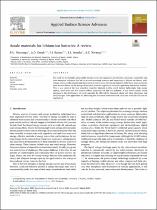| dc.contributor.author | Iwuoha, E.I | |
| dc.date.accessioned | 2022-08-11T11:26:12Z | |
| dc.date.available | 2022-08-11T11:26:12Z | |
| dc.date.issued | 2022 | |
| dc.identifier.citation | P.U. Nzereogu, A.D. Omah, F.I. Ezema, E.I. Iwuoha, A.C. Nwanya, Anode materials for lithium-ion batteries: A review, applied surface science advances, volume 9, 2022, 100233, ISSN 2666-5239, https://doi.org/10.1016/j.apsadv.2022.100233. | en_US |
| dc.identifier.uri | https://doi.org/10.1016/j.apsadv.2022.100233 | |
| dc.identifier.uri | http://hdl.handle.net/10566/7724 | |
| dc.description.abstract | The need for eco-friendly and portable energy sources for application in electrical, electronic, automobile and even aerospace industries has led to an ever-increasing research and innovation in lithium-ion battery technology. Owing to the research and discoveries in recent years, lithium-ion batteries (LIBs) have stood out as the most suitable device for the storage of electrical power for application in mobile appliances and electric vehicles. This is as a result of the very attractive properties inherent in LIBs, which include lightweight, high energy density, small-scale size, few memory effects, long cycle life and low pollution. In this review article, recent advances in the development of anode materials for LIBs will be discussed, along with their advantages and disadvantages. New approaches for alleviating the drawbacks associated with LIB anode materials will also be highlighted. | en_US |
| dc.language.iso | en | en_US |
| dc.publisher | Elsevier | en_US |
| dc.subject | Anode material | en_US |
| dc.subject | Carbon | en_US |
| dc.subject | Lithium-ion battery | en_US |
| dc.subject | Silicon | en_US |
| dc.subject | Transition metal oxide | en_US |
| dc.title | Anode materials for lithium-ion batteries: A review | en_US |
| dc.type | Article | en_US |

